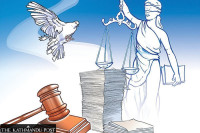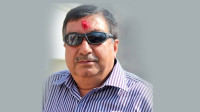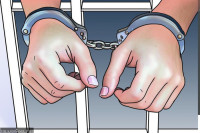National
Questions arise over transfer of chief registrar to High Court
Court insiders claim that Chief Registrar Kunwar was transferred by the acting chief justice to a perceived lower High Court post for supporting suspended Chief Justice Rana.
Tika R Pradhan
On March 10, the Judicial Council headed by acting Chief Justice Deepak Kumar Karki recommended Lal Bahadur Kunwar, the chief registrar at the Supreme Court, for appointment as a High Court justice without mentioning which court.
Kunwar has objected to the decision.
According to Supreme Court officials, Kunwar on Friday handed an application to acting Chief Justice Karki, saying he is not interested in the new position.
The issue many say comes as an indication of yet another conflict in the Supreme Court where the chief of the judiciary appears to be taking decisions unilaterally, a charge the now suspended Chief Justice Cholendra Shumsher Rana faced.
The general practice is that the chief registrar is usually appointed either chief judge or a judge at a High Court.
Previous chief registrar Nahakul Subedi was appointed chief judge of the Tulsipur High Court and then the next chief registrar Rajan Bhattarai was appointed a judge at the Biratnagar High Court.
Some officials, however, defend Kunwar’s appointment as a judge of a High Court because he was elevated faster and had no experience of a judge as he only served in administrative positions and that many of his seniors are still working as District Court judges.
Kunwar was appointed chief registrar on February 11 last year. He succeeded Niraula after the latter was appointed chief judge of the Tulsipur High Court in January. Kunwar was serving as registrar at the Supreme Court.
There are seven High Courts in the country.
With Til Prasad Shrestha, who was serving as the chief judge of the Biratnagar High Court, set to be appointed as a Supreme Court justice, as many as five chief judge positions are vacant.
Of the 160 judge positions at high courts, 17 are currently vacant and the number is set to reach 20 as more will retire soon, according to officials at the Judicial Council.
The Post’s repeated attempts to reach Kunwar went unanswered. Some officials at the Supreme Court, however, said he was not taking calls because he was upset with the decision of the Judicial Council.
Kunwar, according to officials, has been dissatisfied with Karki’s decision, claiming the latest move to transfer him as a judge is tantamount to a demotion.
“Although the acting chief justice is supposed to act as the guardian of all the employees in the judicial service, most of them have taken the move to transfer Chief Registrar Kunwar to High Court as punishment,” said a senior official at the Supreme Court asking not to be named fearing retribution.
“They fear that such actions by the acting chief justice will spoil the work environment and stymie professional growth of those in the judicial service.”
Court staffers suggested that the acting chief justice wants to appoint someone else as chief registrar and therefore he transferred Kunwar to the High Court.
“Because he cannot force Kunwar to resign, he transferred him so that he can appoint someone of his choice as chief registrar,” the official said.
The official said earlier also Supreme Court registrar Nirmala Poudel had refused to take up the post of District Court judge.
Legal experts say the head of the judiciary should facilitate professional growth of judges and officials working under him. Any action taken against anyone motivated by vendetta will further create a mess in the judiciary, which is already undergoing a crisis.
“The latest practice is that the chief registrar’s next appointment is a chief judge. Acting chief justice should follow the practice,” said Chandra Kanta Gyawali, a senior advocate. “The chief justice should establish a rule-based system in the judiciary.”
Karki was the senior-most justice in the Supreme Court when it was headed by Rana. As a member of the Judicial Council, he had written a note of dissent at a Judicial Council meeting when Rana had decided to recommend Nripa Dhwoj Niraula for chief judge of the Patan High Court.
Had Rana, who remains suspended since February 13 when the impeachment motion was filed against him, continued as chief justice, Karki would have retired without becoming acting chief justice.
Supreme Court insiders say since Karki was appointed as head of the judiciary owing to Rana’s suspension, the former should use the opportunity to establish a rule-based system in the larger interest of the judiciary. Karki will retire on October 1.
Some officials said Karki was not happy with the existing set of employees including Chief Registrar Kunwar and Registrar Narayan Panthi because they did not support the struggle by justices and the lawyers against Rana.
But Kunwar’s sympathisers say the chief registrar and registrar were merely following Rana’s orders and had nothing personal against the justices’ protests.
Hari Bhattarai, secretary of the “official” trade union of the Supreme Court, said many employees at the Supreme Court are dissatisfied with the way acting Chief Justice Karki is treating employees.
“If any action is taken against the chief registrar, employees would struggle against the acting chief justice,” said Bhattarai. “It seems the leadership wanted to change the whole set of employees. It’s because of the opposition from employees, actions have not been taken against anyone lately.”
After Karki came to lead the judiciary, Baburam Dahal was removed as the spokesperson for the Supreme Court. Bimal Poudel was given the responsibility.
According to insiders, the new leadership of the Supreme Court seems to be under pressure from the agitators who struggled for several months demanding Rana’s ouster, to get rid of those who supported Rana.
“The judiciary has become a mess. Some are getting promotions pretty quickly, while others have been sidelined, with quite a many even retiring before getting promoted,” said a High Court judge who spoke on the condition of anonymity.




 7.12°C Kathmandu
7.12°C Kathmandu















